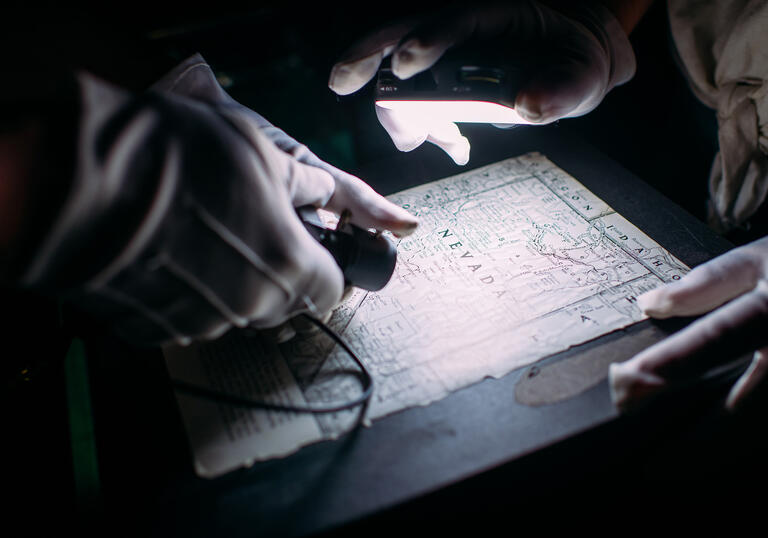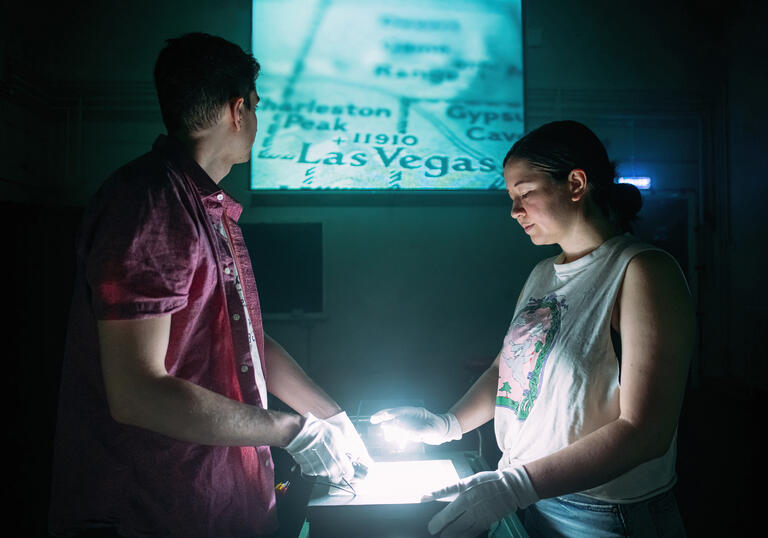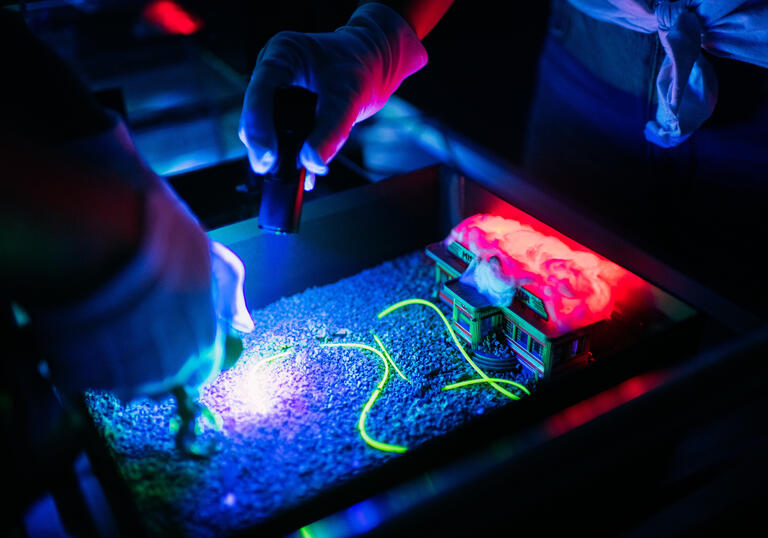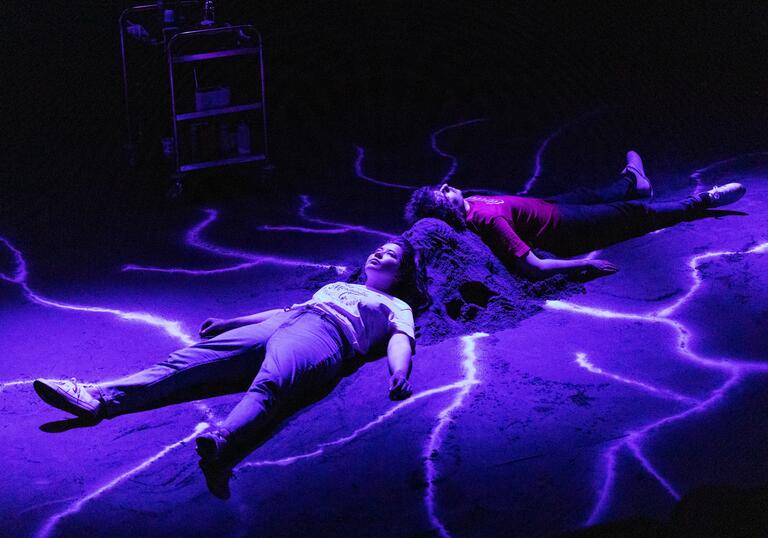
The Company
On stage
Performer Emma Clark
Performer PJ Stanley
Creative Team
Concept Emma Clark and PJ Stanley
Devised by Emma Clark, PJ Stanley, Georgie Hook and Patch Middleton
Scenographer Georgie Hook
Sound Designer Patch Middleton
Lighting Designer Alex Fernandes
Production Manager Pete Rickards for eStage
Technical Stage Manager Sam Marshall
Choreography Consultant Carly McCann

The Power of Alchemy
Rewind to 2021, when a team of four creative collaborators met in a room and gathered around a blank sheet of paper. They looked into an unpredictable future for the world, and began to sketch out thoughts, words and images in response.
Two years on, emma + pj’s Ghosts of the Near Future comes to the Pit after its development through R&D, pilot performances and a spell at Barbican Open Lab. During technical rehearsals, the show’s scenographer, Georgie Hook, and sound designer Patch Middleton reflected on their route here: the processes, the magic of collaboration and what it has meant to ‘design the end of the world’.
How has the show evolved?
Georgie Hook (GH): As co-devisers, Patch and I were in the room from day one, devising alongside Emma and PJ, and bringing the world of the show to life.
Patch Middleton (PM): It’s exciting as a sound designer when the first thing you do in rehearsal is nothing to do with sound but it’s getting a big, blank piece of paper onto which we write exciting words, or it’s throwing ideas together, putting up pictures and generating story ideas and content. Together we were able to develop a real understanding of the world we were creating, ready to jump off into our specific design roles.
GH: I approach design as visual dramaturgy, and that was inherent to this process. We came up with the dramaturgical concepts and did a lot of the world-making together. One of our exercises at the end of each day of R&D was to each write a postcard from the end of the world. Quite quickly we found that we all seemed to be writing from the same world, the same landscapes and invoking similar language, to the point where if you read one aloud you wouldn’t be sure who wrote it.
PM: The postcards were also exploratory: sometimes people would write backwards or in a spiral, or get increasingly smaller or draw things out. That reflected the experimentation for the piece itself. Little bits of the text on those postcards have made it into the show, and into the playtext.
GH: The postcards are an embodiment of the journey of the piece
Take us back to day one of R&D. What was the first provocation?
PM: One was the title: Ghosts of the Near Future. What did that mean? There was the idea of hauntology - being haunted by lost futures. It’s the idea that in the past we were promised one thing in the future, and by the time you get there, we’ve actually got something different. We played with retro elements from the 1950s, Americana, hope for the future when the actual future we’ve got is way less hopeful. And that being a representation of what a ghost in the near future is. We explored the world of the show, which is set in the Nevada desert just outside Las Vegas, and ideas like Vegas as a shoreline where things wash up, the casino which never sleeps, the mirage on the horizon –
GH: – the end of the world as a disappearing act, extinction in its various forms. There was a lot of rich material to work with, which became a way of navigating a story through it.
PM: That was good because I like to be deeply embedded in what the world is and what the characters are going through. For me, it’s always been about alchemy rather than science: play, make mistakes and try wild things that come from understanding the content and then seeing what that makes.
GH: The collaborative approach meant that Patch and I were producing pieces of writing, and Emma and PJ were producing aspects of the design. We all played with objects and materials. Patch would compose a piece of sound and we would do an exercise or write something based on that sound. It was very enmeshed, but also very organic.
How do you corral all of those ideas into a linear experience for an audience?
GH: We created our own vocabulary where we referred to things as ‘shiny’.
PM: Ideas were never ‘good’ or ‘bad’ or given value judgements like that. Stuff that wasn’t quite there was referred to as ‘crispy’, in that it needed to be developed.
GH: It became a tool for filtering out what was and wasn’t working. We had such a strong sense of the dramaturgy that filtering ideas was easier. The strong collaborative foundation we had built helped as we moved into our own areas of design. And we continued to collaborate.
PM: It’s been an exciting process to work like this and create moments of alchemy. Obviously we’ve had the luxury of time. Sometimes the alchemy doesn’t work, but when it does, when that direct group response to a provocation comes together, it is more likely to create a connection with audiences. They become the next member of the group.
What followed R&D?
PM: After a sharing at the end of the initial six weeks, we came to Barbican Open Lab for a week of development time, which was an opportunity to be in a space with all the resources we needed. The second version was an hour long and played at Summerhall at Edinburgh Fringe. This new version for the Barbican is the third, and it’s fuller and longer. The Fringe version allowed us to focus on what we’re really trying to say with the piece, which was really useful for making a longer piece. We built on what was important rather than filling it with exciting ideas that don’t serve the journey.
How did your time at Barbican Open Lab work?
CH: It was a chance to experiment. During the redesign process for this version at the Barbican, I have found myself referring back to videos, ideas and documentation from our time in the Pit for Open Lab. A lot of the ideas need to exist within the theatre space and be explored with the technical elements, and we could see how it would feel with a bank of seats there. It’s rare to be able to devise within the performance space itself.
PM: Often the spaces I work in have sound from the right, sound from the left and sound from a sub, if you’re lucky. Three channels. In the Pit, we are using 14! That really informed my redesign for this version of the show. I’ve gone back to the original sound, split each track into its component parts and I’m sending it into different spaces to create a really 3D immersive sound. Without Open Lab, I wouldn’t have known that was possible. The sound team were always on hand so I’d throw an idea out and ask if we can do it, and they’d say it’s already rigged, we can do it. 95% of this show has ended up featuring sound. The two times we don’t have sound are very specific choices to fall into silence. Otherwise, there’s a bed of sound design throughout, taking us through various genres, various places, various atmospheres. There is a rhythm to the show, with heartbeats, swells and tension.
Each time you come to the end of making a version, do you want to try more things out?
PM: The double-edged sword of having time for world-building is that by the time you get to the end of making a version, you still feel there are a thousand more versions you could do! There are so many images, ideas and pieces of writing.
GH: It’s two years since we started this process. In that time you change as a person and therefore have new perspectives on the show. Certain lines or moments will land more depending on what place you’re at in your life.
PM: It’s the same thing as having a fixed text. A novel you read as a child might seem different when you read it as an adult. There’s a flexibility within each person as well as the show.
GH: The show is also responding to our changing landscapes, our changing world –
PM: – our fears and hopes, all the big human truths.
What does success look like?
PM: Without being too grandiose, I’d love to blow the audience’s minds. But really the ideas in this piece are massive. One of Emma’s provocations was that thinking about the end of the world is like staring at the sun – you can’t do it too much because it hurts. You have to look around it.
And yet the end of the world is constantly at the back of our minds: increasing disasters from climate change, destabilisation across nations of the world, increasing wealth gaps. More than that, we’ve had 100 years of humanity dealing with its own demise: two world wars, the threat of nuclear annihilation, then more recently the environment. The baton has been passed from generation to generation. The world feels like it could go horribly wrong, so how do you go to the shops to buy milk, have a laugh with your friends or find the joy?
This piece is trying to deal with that in a way that is funny but touching, massive and tiny at the same time. We want to provide the space for the audience to reflect on those things and maybe just stare at the sun for a little bit.
GH: Striking a chord is important. You know that feeling you can have in your solar plexus, when something shifts, or something impacts you that you weren’t aware of, an emotion? I’d like to think that after seeing the show, something might shift for the audience.
PM: It’s the only show I know that contains a giant rabbit costume and ten minutes later a beautiful idea that will make you cry.
Biographies
Emma Clark
Performer, Concept, Deviser
Emma Clark is an artist from California working between performance, film, installation and experience design. She builds worlds that explore the intimacy of human experience against the backdrop of global upheaval, migration and change. She has previously been supported by Kakilang (formerly Chinese Arts Now) and New Diorama Theatre, where she is now Creative Associate. She was a 2019 Total Theatre Award nominee for the accident did not take place with YESYESNONO and in 2021 was a delegate to the Creative Freelancers: Shaping London’s Recovery task force sponsored by the Mayor of London, Fuel Theatre and Actors Touring Company. She is the co-founder and co-Artistic Director of emma + pj (est. 2018). Outside of the company, she has developed and presented work at The Public Theater, The Flea, Soho Theatre, HERE Arts Center, Chelsea Theatre, Rose Theatre, Bristol Old Vic, HOME and PULSE Festival.
PJ Stanley
Performer, Concept, Deviser
PJ Stanley is an interdisciplinary artist working across theatre, installation, games and performance design. A world-builder at heart, they create playful, provocative live experiences that explore speculative futures and post-capitalist ideologies. They trained in Advanced Theatre Practice at the Royal Central School of Speech and Drama in 2017, graduating with distinction. In 2018, they co-founded the production company emma + pj, where they are co-Artistic Director. In 2021 they were a delegate to the Creative Freelancers: Shaping London’s Recovery task force sponsored by the Mayor of London, Fuel Theatre, and Regent’s Park Open Air Theatre. In 2022, they were a Barbican Open Lab resident artist and Play Artist in Residence at The Spring Arts and Heritage Centre. Their performance work has been nominated for two OFFIE awards (Crystal Clear, 2019) and been published worldwide (Ghosts of the Near Future, 2022).
Georgie Hook
Scenographer and Deviser
Georgie Hook is a performance designer and researcher. Her practice is engaged with the creation of new devised work, understanding design as visual dramaturgy. She has worked alongside a number of exciting theatre artists – including emma + pj and YESYESNONO – at venues such as York Theatre Royal, Summerhall and Theatr Clwyd. She is currently undertaking a PhD at the University of Leeds, funded by AHRC. Her research reimagines experiences of home through creative scenographic methods. She has also published work in the Studies in Theatre and Performance journal, writing on the significance of everyday objects in performance.
Patch Middleton
Sound Designer and Deviser
Patch Middleton is a writer, sound designer and composer from Cumbria but now based in Manchester, fascinated by work that explores the strange and fantastical and how this correlates to identity, both personal and local, and the fears and hopes we hold. Recent work has included: soundlandscape, a series of audio-theatre ghost story walks in Yorkshire and Cumbria; The Witness, a storytelling piece about the Gospel of Mary Magdalene with storyteller and interdisciplinary performer Jo Blake, and composing for showcases at LIPA.
Alex Fernandes
Lighting Designer
Alex Fernandes is a lighting designer for contemporary performance, and was the recipient of the 2013 Michael Northen Bursary. He was the technical director of Forest Fringe between 2013 and 2016. Lighting work includes DOMESTICA at Battersea Arts Centre and on UK and international tour; Swimming Pools at Teatro de la Abadia and on Spanish tour; Double Double Act at the Unicorn; Système AI at Sadler’s Wells; Minor Planets for HAU Berlin; Kim Kardashian at Balé da Cidade de Palmas, Brazil; Heartbreaking Final for Wiener Festwochen and Centre Pompidou; Two Billion Beats at the Orange Tree; Paradise Now! at the Bush; and L’Addition at Avignon International Festival.
Carly McCann
Choreography Consultant
Carly McCann is a London-based choreographer, multidisciplinary creative practitioner and actor. Her recent work includes Milestones at the Bloomsbury Theatre; Stranger Things: The Experience at Troubadour Brent Cross Studios; Mad Women at St Margaret’s House; MADDY and RawTransport (also on tour) at VAULT Festival; Here 4 U at Oxford Playhouse; and Borrowing Us for Clapham Fringe. She is a graduate of the Royal Central School of Speech and Drama’s Advanced Theatre Practice programme and is the co-founder of Electrick Village, an immersive, sensory, VR theatre company.

About emma + pj
emma +pj is a UK/USA performance duo working at the intersection of theatre, installation and live art. Their recent work explores humanity in extreme landscapes, creating cinematic, otherworldly environments that invite us to reimagine our place in the world. Recent projects include: Atlantic, a clown romance about tectonic plates at VAULT Festival; Obsession Party, a primary school Coachella at the Yard; and The Spirit of Havant Spring, a folkloric escape room for young people at the Spring Arts and Heritage Centre. They’ve presented new work at Shoreditch Town Hall, The Yard, Camden People’s Theatre, Battersea Arts Centre, Summerhall, New Diorama Theatre and VAULT Festival. They were Barbican Open Lab resident artists for 2021/22 with Ghosts of the Near Future, The Spring Play Artists in Residence for Autumn/Winter 2022, and facilitators of the Yardlings: Bigger programme at The Yard Theatre in 2018/19. In 2023, they published a print edition of Ghosts of the Near Future with Bloomsbury UK/Methuen Drama.
@emmaandpj
https://www.emmaandpj.com/
Acknowledgements
Special thanks to those who have supported the development of this piece, including: David Byrne, Will Young, Guy J Sanders, and the teams at New Diorama Theatre and NDT Broadgate; Liz Eddy, Anna Dominian, Leanne Cosby, Mali Siloko, Saxon Mudge, Toni Racklin, and the Barbican theatre and Open Lab teams; Caroline Hall, Lucinda Hamlin and the Barbican production, marketing and stage management teams; Pete Rickards, Ian Taylor, Lewis Champney and the team at eStage; Sam Marshall; Sue Stanley and Gabe Hearst; Jemima Yong, Marie Klimis, Virginie Taylor and Ash Williams; Miriam Attwood, Emma Ainley-Walker and the team at Storytelling PR; Serena Grasso and the team at Methuen Drama; The Maria Björnson Memorial Fund; and The Carol Tambor Theatrical Foundation.
The Barbican Theatre Open Lab programme
The Barbican Theatre Open Lab programme gives artists the opportunity to develop a new project, idea or performance as well as taking part in a year-long programme of support.
The programme has supported over 24 artists for over four years with practices ranging from dance, theatre, visual arts and circus. We’re dedicated to continually improving and developing the programme to support the artists that need the space and opportunity. Open Lab will be paused for the next year while we explore additional ways of supporting this important artist development programme.

For the Barbican
Barbican Centre Board
Chair
Tom Sleigh
Deputy Chair
Sir William Russell
Deputy Chair
Tobi Ruth Adebekun
Board Members
Randall Anderson, Munsur Ali, Stephen Bediako OBE, Farmida Bi CBE, Tijs Broeke, Zulum Elumogo, Wendy Mead OBE, Mark Page, Alpa Raja, Jens Riegelsberger, Jane Roscoe, Irem Yerdelen, Despina Tsatsas, Michael Asante MBE
Clerk to the Board
Kate Doidge and Ben Dunleavy
Barbican Centre Trust
Chair
Farmida Bi CBE
Vice Chair
Robert Glick OBE
Trustees
Farmida Bi CBE, Tom Bloxham MBE, Stephanie Camu, Tony Chambers, Cas Donald, Robert Glick OBE, David Kapur, Ann Kenrick, Kendall Langford, Sir William Russell, Tom Sleigh, Claire Spencer AM, Sian Westerman
Directors
Chief Executive Officer
Claire Spencer
Director of Development
Natasha Harris
Director of People, Inclusion and Culture
Ali Mirza
Head of Finance & Business Administration
Sarah Wall
Acting Director for Buildings and Renewal
Cornell Farrell
Director of Commercial
Jackie Boughton
Senior Executive Assistant to Claire Spencer
Jo Daly
Theatre Department
Head of Theatre and Dance
Toni Racklin
Senior Production Manager
Simon Bourne
Producers
Liz Eddy, Jill Shelley, Fiona Stewart
Assistant Producers
Saxon Mudge, Mali Siloko, Bridget Thornborrow, Tom Titherington
Production Managers
Jamie Maisey, Lee Tasker
Technical Managers
Steve Daly, Jane Dickerson, Nik Kennedy, Martin Morgan, Stevie Porter
Stage Managers
Lucinda Hamlin, Charlotte Oliver
Technical Supervisors
James Breedon, John Gilroy, Jamie Massey, Matt Nelson, Adam Parrott, Lawrence Sills, Chris Wilby
PA to Head of Theatre
David Green
Production Administrator
Caroline Hall
Production Assistant
Michaela Harcegová
Technicians
Kendell Foster, Burcham Johnson, David Kennard, Bartek Kuta, Christian Lyons, Josh Massey, Fred Riding, Fede Spada
Stage Door
Julian Fox, aLbi Gravener
Creative Collaboration and Learning
Head of Creative Collaboration
Karena Johnson
Producer
Lauren Brown
Assistant Producer
Rikky Onefeli
Marketing Department
Head of Marketing
Jackie Ellis
Deputy Head of Marketing
Ben Jefferies
Senior Marketing Manager
Kyle Bradshaw
Marketing Assistant
Rebecca Moore
Communications Department
Head of Communications
James Tringham
Senior Communications Manager
Ariane Oiticica
Communications Manager
HBL
Communications Assistant
Sumayyah Sheikh
Audience Experience
Deputy Head of Audience Experience & Operations
Sheree Miller
Ticket Sales Managers
Lucy Allen, Oliver Robinson, Ben Skinner, Jane Thomas
Operations Managers
Seán Carter, Rob Norris, Elizabeth Davies-Sadd, Samantha Teatheredge, Hayley Zwolinska
Operations Manager (Health & Safety)
Mo Reideman
Audience Event & Planning Manager
Freda Pouflis
Venue Managers
Scott Davies, Tilly Devine, Tabitha Goble, Nicola Lake, Maria Pateli
Assistant Venue Managers
Rhiannon Brennan, Melissa Olcese, Daniel Young
Crew Management
Dave Magwood, Rob Magwood, James Towell
Access and Licensing Manager
Rebecca Oliver
Security Operations Manager
Naqash Sheik
The PappyShow: 10th Birthday Pit Party
Join The PappyShow for celebratory evening of bold and beautiful dance, music and the best of vibes.
With thanks
The Barbican is London's creative catalyst for arts, curiosity and enterprise. We spark creative possibilities and transformation for artists, audiences and communities – to inspire, connect, and provoke debate.
We're committed to making a difference locally, nationally and internationally by showcasing some of the most inspiring and visionary work by artists and communities. We're not-for-profit. Each year we need to raise 65% of our income through fundraising, ticket sales, and commercial activities. Our supporters play a vital role in keeping our programme accessible to everyone, which includes our work with local schools; development opportunities for emerging creatives; and access to discounted and subsidised tickets.
Barbican supporters enjoy behind the scenes access across the centre and see first-hand what their gift enables through enhanced priority booking, as well as access to tickets for sold-out performances and exclusive events. For more information please visit www.barbican.org.uk/join-support/support-us or contact [email protected].
With thanks...
Founder and principal funder
The City of London Corporation
Major Supporters
Arts Council England
Calouste Gulbenkian Foundation (UK Branch)
Kiran Nadar Museum of Art
SHM Foundation
Sir Siegmund Warburg’s Voluntary Settlement
The Terra Foundation for American Art
Leading Supporters
Trevor Fenwick and Jane Hindley
Marcus Margulies
Programme Supporters
Marie-Laure de Clermont-Tonnerre (Spirit Now London)
Sayeh Ghanbari
Goodman Gallery
Kristin Hjellegjerde Gallery
Elizabeth and J Jeffry Louis
Pat and Pierre Maugüé
Hugh Monk
Romilly Walton Masters Award
Jack Shainman Gallery
The Rudge Shipley Charitable Trust
Director’s Circle
Anonymous (1)
James and Louise Arnell
Farmida Bi CBE
Jo and Tom Bloxham MBE
Philippe and Stephanie Camu
Cas Donald
Alex and Elena Gerko
Trevor Fenwick and Jane Hindley
Sian and Matthew Westerman
Corporate Supporters
Audible
Bank of America
Bloomberg
Bolt Burdon Kemp
Campari
Google Arts & Culture
Linklaters LLP
Norton Rose Fulbright
Osborne Clarke
Pinsent Masons
Standard Chartered
Sotheby’s
Slaughter and May
Taittinger
UBS
Vestiaire Collective
Trusts & Grantmakers
The Austin and Hope Pilkington Charitable Trust
Art Mentor Foundation Lucerne
Art Fund
Bagri Foundation
CHK Foundation
Cockayne – Grants for the Arts
Fluxus Art Projects
John S Cohen Foundation
Embassy of the Kingdom of the Netherlands
Goethe-Institut London
Helen Frankenthaler Foundation
High Commission of Canada in The United Kingdom
Italian Cultural Institute in London
Korean Cultural Centre UK
Kusuma Trust UK
London Community Foundation
Mactaggart Third Fund
Maria Björnson Memorial Fund
Peter Sowerby Foundation
The Polonsky Foundation
Rix-Thompson-Rothenberg Foundation
SAHA Association
Swiss Cultural Fund
U.S. Embassy London
We also want to thank the Barbican Patrons, members, and the many thousands who made a donation when purchasing tickets.
The Barbican Centre Trust Ltd, registered charity no. 294282
